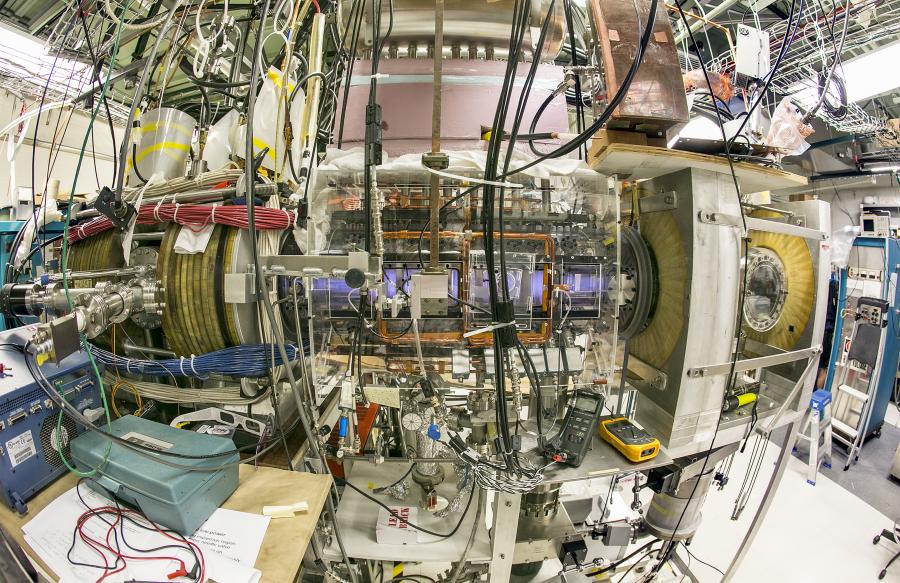
Fusion-powered spacecraft may not be just a sci-fi dream for much longer.
The Direct Fusion Drive (DFD) engine could take flight for the first time in 2028 or so, if all goes according to plan, the concept's developers said.
That would be big news for space fans; the minivan-size DFD could get a 22,000-lb. (10,000 kilograms) robotic spacecraft to Saturn in just two years, or all the way out to Pluto within five years of launch, project team members said. (For perspective: NASA's Cassini mission made it to Saturn in 6.75 years, and it took the agency's New Horizons probe 9.5 years to get to Pluto.)
Related: Superfast Spacecraft Propulsion Concepts (Images)
And the engine doubles as a potent power source, meaning the technology could have a broad range of off-Earth applications.
For example, the DFD could help power NASA's planned moon-orbiting space station, known as the Gateway, as well as bases on the moon and Mars, project team member Stephanie Thomas, vice president of Princeton Satellite Systems in Plainsboro, New Jersey, said late last month during a presentation with NASA's Future In-Space Operations working group.
The DFD is a variant of the Princeton Field-Reversed Configuration (PFRC), a fusion-reactor concept invented in the early 2000s by Samuel Cohen of the Princeton Plasma Physics Laboratory (PPPL). The DFD is basically a PFRC reactor with an open end, through which exhaust flows to generate thrust, Thomas explained.
Get the Space.com Newsletter
Breaking space news, the latest updates on rocket launches, skywatching events and more!
The DFD's interior will feature a magnetically contained hot plasma of helium-3 and deuterium, a special "heavy" type of hydrogen that has one neutron in its nucleus (as opposed to "normal" hydrogen, which has no neutrons). Atoms of these elements will fuse within this plasma, generating lots of energy — and very little dangerous radiation, Thomas said.
The fusing plasma heats up cool propellant flowing outside the confinement region. This propellant is directed out a nozzle at the back of the engine, producing thrust.
All that heat translates to a lot of power — likely between 1 and 10 megawatts, Thomas said. The DFD will tap into that power, using a "Brayton cycle" engine to convert much of the heat into electricity.
That means a DFD mission would be able to do a great deal of science work after reaching its destination. For example, a fusion-equipped Pluto orbiter could beam down power to a lander on the dwarf planet's surface and also send high-definition video back to Earth, Thomas said.
Nuclear fusion is legendarily difficult to harness; nobody has yet succeeded in demonstrating a full-scale, commercially viable fusion reactor. (As the old joke goes, "Fusion is the energy source of the future, and always will be.") But Thomas and her team think their concept has a very real chance of success.
"DFD is different from other fusion-reactor concepts," she said, citing the concept's small size, clean operation, low radiation and unique plasma-heating method (which employs a radio-wave antenna).
The DFD team has secured funding from a variety of agencies recently to continue developing the concept. For example, work from 2016 through 2019 was aided by two rounds of funding from the NASA Innovative Advanced Concepts program, which aims to nurture the development of potentially revolutionary spaceflight technology.
And DFD received an Advanced Research Projects Agency-Energy (ARPA-E) award this year, which will fund further development through next year.
The team has already demonstrated some core concepts with the PFRC-1 experiment, which ran at PPPL from 2008 through 2011, and PFRC-2, which is operating now. The researchers have not yet achieved fusion, but they hope to do so with PFRC-4 in the mid-2020s.
A flight prototype would follow shortly thereafter. An actual mission could come on the heels of a successful demonstration flight — perhaps as early as 2028, Thomas said.
- Has This Startup Cracked the Secret to Fusion Energy?
- Proton Fusion, the Sun's Power Source, Explained (Infographic)
- Quick Fusion-Powered Trips to Mars No Fantasy, Scientists Say
Mike Wall's book about the search for alien life, "Out There" (Grand Central Publishing, 2018; illustrated by Karl Tate), is out now. Follow him on Twitter @michaeldwall. Follow us on Twitter @Spacedotcom or Facebook.
Join our Space Forums to keep talking space on the latest missions, night sky and more! And if you have a news tip, correction or comment, let us know at: community@space.com.

Michael Wall is a Senior Space Writer with Space.com and joined the team in 2010. He primarily covers exoplanets, spaceflight and military space, but has been known to dabble in the space art beat. His book about the search for alien life, "Out There," was published on Nov. 13, 2018. Before becoming a science writer, Michael worked as a herpetologist and wildlife biologist. He has a Ph.D. in evolutionary biology from the University of Sydney, Australia, a bachelor's degree from the University of Arizona, and a graduate certificate in science writing from the University of California, Santa Cruz. To find out what his latest project is, you can follow Michael on Twitter.









